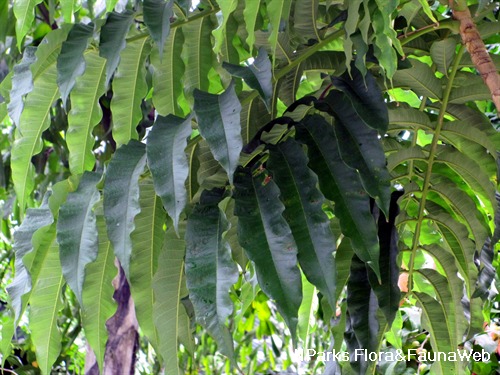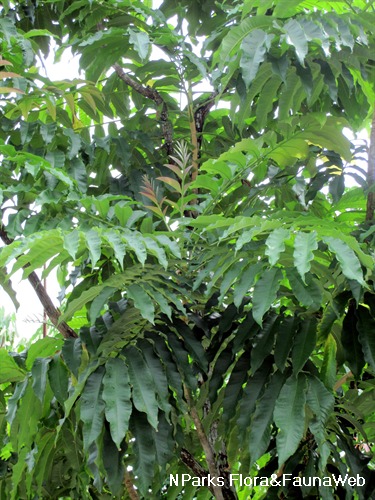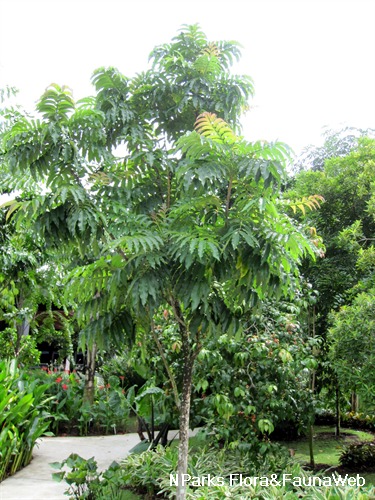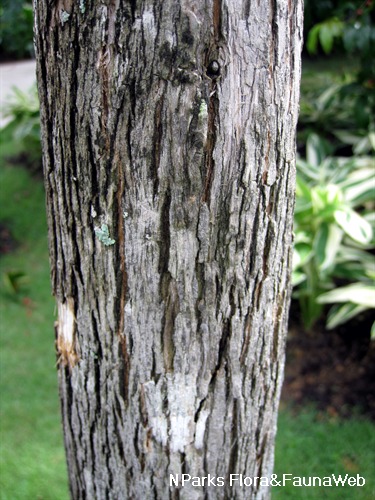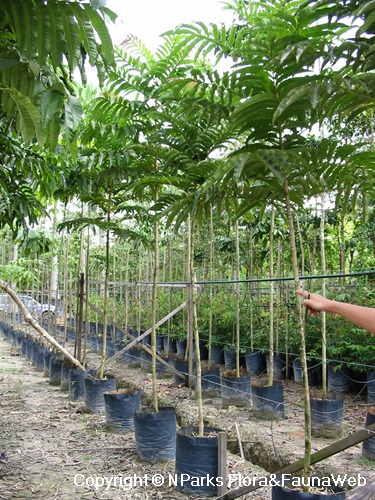_lowres.jpg)
Back
Peronema canescens Jack
| Family Name: | Lamiaceae (Labiatae) |
| Synonyms: | Peronema heterophyllum Miq. |
| Common Name: | Sungkai, False Elder, Kurus, Jati Sabrang, Sukai, Cherek |
Peronema canescens, also known as Sungkai, is a tree which is native to Singapore. Growing up to 35 m tall, it has compound leaves with distinct winged rachis. Young leaves may appear purplish and turn green when mature. The timber is both strong and attractive. It is often used to make roof trusses, bridges, furniture, cabinets and even veneer.
Name
Classifications and Characteristics
| Plant Division | Angiosperms (Flowering Seed Plants) |
|---|---|
| Plant Growth Form | Tree |
| Lifespan (in Singapore) | Perennial |
| Mode of Nutrition | Autotrophic |
| Plant Shape | Irregular |
| Maximum Height | 10 m to 35 m |
Biogeography
| Native Distribution | Thailand, Peninsular Malaysia, Sumatra and Borneo |
|---|---|
| Native Habitat | Terrestrial |
| Preferred Climate Zone | Tropical |
| Local Conservation Status | Native to Singapore (Presumed Nationally Extinct (NEx)) |
Description and Ethnobotany
| Growth Form | It is a tree, about 10 – 35 m tall and up to 1.2 m wide, with buttresses. The small branches have distinct interpetiolar ridge. The bark is grey-brown, shallowly fissured and scaly. |
|---|---|
| Foliage | The leaves can reach (15 -) 25 to 30 (-90) cm long and are pinnately compound with 4 – 19 leaflets. Each leaflet is elliptic to lanceolate (2.5 – 35 cm long and 1 – 7.5 cm wide) with 10 – 30 pairs of lateral veins which are prominently visible on the underside. The leaflet base is wedged-shaped (cuneate), sometimes asymmetrical, while the leaflet tip is tapering (acuminate). The rachis is often winged and the leaf stalk is 3 – 5 (-18) cm long. Young leaves may appear purplish and the hairs on the underside of the leaflets are dull red-brown. Mature leaflets are glabrous on the upper surface while the underside is covered with greyish hairs. The leaflet margin is toothed (serrate) when young and becomes entire as it matures. |
| Flowers | Flowers occur in a cluster as a panicle inflorescence at the terminal or axillary position. Inflorescence is branched, reaching to 25 – 60 cm long. The flower is small, white to greenish white with a tinge of purple at the margin. |
| Fruit | The fruit is dry, capsular and mostly round, about 3 – 3.5 mm diameter. It is covered with long soft hairs (villose) and splits open when mature. |
| Habitat | It is found in rainforest and disturbed areas, often near streams, from 30 – 900 m altitude. |
| Associated Fauna | Flowers are pollinated by insects. |
| Cultivation | It can be propagated by seed. |
| Etymology | In Greek, peros means disabled and nema means thread. They refer to the two reduced thread-like stamens. The specific epithet canescens means greyish in Latin. |
Fauna, Pollination and Dispersal
| Seed or Spore Dispersal | Abiotic |
|---|
Plant Care and Propagation
| Light Preference | Full Sun |
|---|---|
| Water Preference | Moderate Water |
| Plant Growth Rate | Moderate |
| Rootzone Tolerance | Well-Drained Soils |
Foliar
| Mature Foliage Colour(s) | Green |
|---|---|
| Prominent Young Flush Colour(s) | Purple |
| Foliar Type | Compound |
| Foliar Arrangement Along Stem | Opposite |
| Foliar Attachment to Stem | Petiolate |
| Foliar Venation | Pinnate / Net |
| Foliar Margin | Entire |
| Foliar Apex - Tip | Acuminate |
| Foliar Base | Cuneate, Oblique / Asymmetrical |
| Leaf Area Index (LAI) for Green Plot Ratio | 3.0 (Tree - Intermediate Canopy) |
Non - Foliar and Storage
| Trunk Type (Non Palm) | Woody |
|---|---|
| Mature Bark Texture | Scaly, Fissured |
| Stem Type & Modification | Woody |
| Root Type | Underground |
Floral (Angiosperm)
| Flower & Plant Sexuality | Bisexual Flowers |
| Flower Grouping | Cluster / Inflorescence |
|---|---|
| Flower Location | Terminal, Axillary |
Fruit, Seed and Spore
| Fruit Classification | Simple Fruit |
|---|---|
| Fruit Type | Dehiscent Dry Fruit , Capsule |
| Seed Quantity Per Fruit | Few (1-5) |
References
| References | Bramley, G.L.C. (2019). Lamiaceae. In: van Welzen, P.C. (ed.) Flora Malesiana, ser. 1, vol. 23, pp. 1–424. Leiden: Naturalis Biodiversity Center. Lemmens, R.H.M.J. and Soerianegara, I. (eds). (1993). Plant Resources of South-East Asia Volume 5 (1). Timber trees: Major commercial timbers. Indonesia: Prosea Foundation. 610 pages. |
|---|
Image Repository
Others
| Master ID | 1767 |
|---|---|
| Species ID | 3060 |
| Flora Disclaimer | The information in this website has been compiled from reliable sources, such as reference works on medicinal plants. It is not a substitute for medical advice or treatment and NParks does not purport to provide any medical advice. Readers should always consult his/her physician before using or consuming a plant for medicinal purposes. |

_lowres.jpg)
